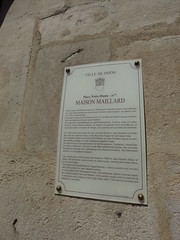Commemorated on 1 plaque
Place Notre-Dame - no 7 Maison Maillard Cette maison fut élevée à partir de 1565 par le victomte-mayeur Jean Maillard qui avait déjà entrepris la construction de son autre maison, du même nom, au no 38 rue des Forges. La façade a peut-être été réalisée selon un modèle de l'artiste Hugues Sambin, qui avait déjà œuvré por Jean Maillard. Son décor est caractéristique du style Renaissance : frontons, têtes et mufles de lions, fruits et fleurs sculptés. Au centre, une grande niche dominée par un cartouche abrite une statue de Vierge. Les lucarnes sont accotées de cariatides.
English translation: Place Notre-Dame - no 7 House Maillard This house was raised from 1565 by Jean Maillard, mayor of Dijon. Who had already begun the construction of his other house of the same name at No. 38 rue des Forges. The facade may have been made according to a model of the artist Hugues Sambin, who had already worked for Jean Maillard. Its decoration is characteristic of the Renaissance style: pediments, heads and muzzles of lions, fruits and carved flowers. In the center, a large niche dominated by a cartridge houses a statue of the Virgin. The dormers are crowned with caryatids.
7 Place Notre Dame, Dijon, France where they designed
